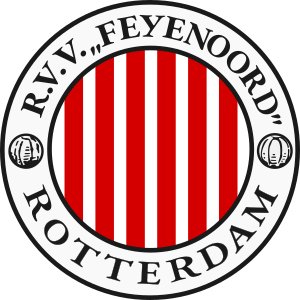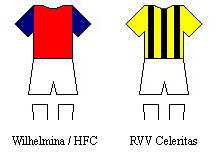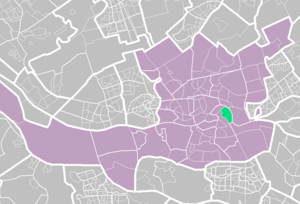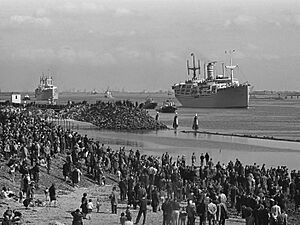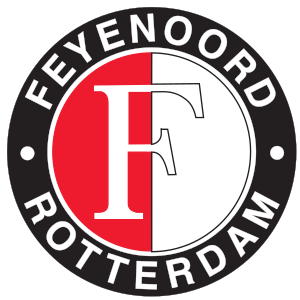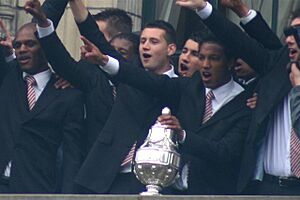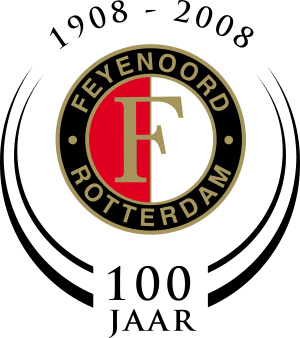History of Feyenoord facts for kids
Feyenoord is a famous Dutch football club from the city of Rotterdam. It was started in 1908 and has a long and successful history. Over almost 100 years, Feyenoord has won many important trophies, including their first national championship in 1924.
Contents
Early Years: 1908-1939
The football club started on 19 July 1908, first called Wilhelmina. They wore red shirts with blue sleeves and white shorts. In 1909, the club changed its name to Hillesluise Football Club. They joined the Rotterdam Football Association. Because another team was already called HFC, they changed their name again to RVV Celeritas.
With the new name, they also got new colors: yellow and black striped shirts with white shorts. In 1912, Celeritas moved up to the national football league. Since there was another Celeritas team there, they changed their name one more time to SC Feijenoord. This name came from the part of the city where the team was founded. They also changed their uniform to the red and white shirts, black shorts, and black socks they still wear today. In 1917, Feijenoord was promoted to the top division and moved to a new field called Kromme Zandweg.
Just three years after reaching the top league, Feijenoord won their first big prize in 1924: the national league championship! They had a great time in the late 1920s, winning their division several times and taking their second national championship in 1928.
Feijenoord won their first Dutch Cup in 1930. They beat their local rivals Excelsior Rotterdam 1–0 in the final. They kept winning their division for three years in a row. In 1935, they won the Dutch Cup again, beating Helmond Sport.
More and more fans came to watch games at the Kromme Zandweg stadium. So, in 1933, the club decided to build a new, bigger stadium. With help from a businessman named Daniël George van Beuningen, they bought land. A special stadium was designed, which was unique in Europe at the time. It was an oval stadium with two levels, where the top level hung over the bottom one. Construction started on 23 July 1935. Feijenoord played their first game in the new Feijenoord Stadion, nicknamed "De Kuip" (meaning "the Tub"), on 27 March 1937. Leen Vente scored the first goal in the new stadium. A few months later, the Dutch national team played Belgium there.
During this time, Feijenoord won three division titles in a row from 1936 to 1938. They also won their third and fourth national championships in 1936 and 1938.
Mid-Century Challenges: 1940-1969
During World War II, Feijenoord played their games at Sparta Rotterdam's stadium because their own stadium, De Kuip, was taken over. When Sparta's stadium was busy, Feijenoord played at their old ground, Kromme Zandweg.
Feijenoord won another national championship in 1940, their fifth Dutch title. Football continued during the war, but the 1945 championship was canceled. After the war, Feijenoord didn't play as well as before. The war had a big impact on Rotterdam, and people were less interested in football.
As Rotterdam rebuilt after the war, the club struggled to win trophies. In 1954, Feyenoord's chairman Cor Kieboom helped start professional football in the Netherlands. Feijenoord was one of the first clubs in the new Eredivisie league in 1954/1955 and has never been relegated since. A memorable game from these early professional years was in 1956, when Feijenoord beat De Volewijckers 11–4, with Henk Schouten scoring nine goals! In 1957, 46,000 fans came to De Kuip for the first night match, where new floodlights were used.
Feijenoord won their first professional Eredivisie Championship, and their sixth Dutch Championship overall, in 1961. On their way to the title, they beat Ajax 9–5 in De Kuip, with Henk Schouten scoring four goals. The next season, they played their first European Cup match. They beat IFK Göteborg easily but were then knocked out by Tottenham Hotspur. In 1962, Feijenoord won the Dutch Championship again.
On 12 December 1962, Feyenoord played a very important European Cup match against Vasas SC. Both teams had won their home games 1–0, so a deciding match was played in Antwerp, Belgium. About 30,000 Feijenoord fans traveled there to watch. Feijenoord won 1–0, with Rinus Bennaars scoring the only goal. This game created a lasting friendship between Feyenoord fans and Royal Antwerp FC fans.
In 1963, thousands of Feijenoord fans sailed on two ships, the SS Groote Beer and the Waterman, to Lisbon for a European Cup semi-final against S.L. Benfica. Feijenoord lost the match, but this was the start of a very successful time for the club. Feijenoord won the double (both the league and the cup) for the first time in 1965, and again in 1969. In 1965, they played Real Madrid in the European Cup. The game was stopped because of rough play and fans entering the field. Real Madrid won the second game easily and went on to win the European Cup that season.
Golden Era and New Challenges: 1970-1999
As the 1969 Dutch champions, Feijenoord played in the European Cup 1969-70. After big wins, they faced AC Milan. Feijenoord lost 1–0 away but won 2–0 at home to move on. They then beat Vorwärts Berlin and Legia Warszawa to reach their first European final. Ajax had reached the final the year before but lost. Feijenoord played Celtic in the final in Milan. The score was 1–1 after 90 minutes. Three minutes before the end of extra time, Ove Kindvall scored the winning goal, making Feijenoord the first Dutch team to win a major European trophy!
As cup holders, Feijenoord played in the European Cup 1970-71. They were surprisingly knocked out early by UT Arad. However, as European champions, Feijenoord played Estudiantes La Plata in the Intercontinental Cup. The first game in Argentina was a 2–2 draw. Back in Rotterdam, Feijenoord won 1–0 with a goal by Joop van Daele, becoming the first Dutch team to win the world club title! In 1971, Feijenoord won their 10th Dutch Championship.
In 1973, the club changed its name to Feyenoord because people outside the Netherlands found the "ij" in Feijenoord hard to say. Under their new name, they played in the UEFA Cup 1973-74. They reached the final after beating VfB Stuttgart. Their opponent in the final was Tottenham Hotspur. The first game was a 2–2 draw. Feyenoord then won their home match 2–0, becoming the first Dutch team to win the UEFA Cup. After this, some Spurs fans caused trouble, which was a new problem for Dutch football. In the rest of the 1970s, Feyenoord won only one more trophy: the Dutch Championship in 1974. In 1978, the club split into two teams: Feyenoord for professionals and Sportclub Feyenoord for amateur players.
Feyenoord won their fifth Dutch Cup in 1980, beating Ajax 3–1 in the final.

In 1984, Feyenoord had another great season, winning the double for the third time. Key players included Johan Cruyff, Ruud Gullit, and Peter Houtman. Cruyff had left Ajax to join their rivals Feyenoord, which made Ajax even more determined to beat them. Feyenoord suffered a huge 8–2 loss to Ajax in Amsterdam. However, Feyenoord later beat Ajax 4–1 in Rotterdam and also knocked them out of the Dutch Cup. Feyenoord then won both the league and the cup, beating Fortuna Sittard in the cup final.
After this success, Feyenoord had a difficult period. In 1989/1990, the club almost got relegated from the Eredivisie. They also had money problems, and their main sponsor went bankrupt.
Things started to get better when Wim Jansen became the temporary manager. Feyenoord beat PSV, the strongest Dutch club at the time, in the KNVB Cup. Feyenoord went on to win the 1991 cup final, beating BVV Den Bosch 1–0. As cup winners, they played against champions PSV in the 1991 Dutch Supercup, which Feyenoord won 1–0. They won another Dutch Cup in 1992, beating Roda JC 3–0. That same year, Feyenoord reached the semi-finals of the UEFA Cup Winners' Cup 1991-92.
In 1993, Feyenoord won another Dutch Championship by beating FC Groningen 5–0 in the last game of the season. Many Feyenoord fans watched the game on big screens in De Kuip. This title was followed by two more Dutch Cups in 1994 and 1995. In the 1995 KNVB Cup, Feyenoord beat Ajax in extra time, becoming the only team to beat Ajax that season, as Ajax won the league and Champions League unbeaten. In the UEFA Cup Winners' Cup 1995-96, Feyenoord reached the semi-finals, with 14,000 fans traveling to Germany to support them.
Feyenoord played in the UEFA Champions League for the first time in UEFA Champions League 1997-98. They finished third in their group but managed to beat Manchester United and Juventus at home. On 25 April 1999, Feyenoord won their 14th Dutch Championship. 250,000 fans celebrated in Rotterdam. Before the new 1999/2000 season, Feyenoord won their second Dutch Supercup, beating Ajax 3–2.
Recent History: 2000s and Beyond
In the UEFA Champions League 1999-00, Feyenoord reached the second group stage. They won against Olympique Marseille and S.S. Lazio, but were eventually knocked out.

Feyenoord played in the Champions League again in 2001-02. They finished third in their group, which meant they continued their European journey in the UEFA Cup 2001-02. They beat SC Freiburg and Rangers, then faced fellow Dutch team PSV in the quarter-finals. Both games were 1–1 draws, leading to extra time and a penalty shootout. Pierre van Hooijdonk, who scored many goals from free kicks that season, scored a late equalizer and then the winning penalty. After beating Inter in the semi-finals, Feyenoord reached the final against Borussia Dortmund. The final was held in De Kuip, so most fans were Feyenoord supporters. Feyenoord won 3–2, with goals from Pierre van Hooijdonk and Jon Dahl Tomasson, making them the champions!
A huge party happened in and around De Kuip. However, the official celebration in the city center was canceled because a local politician, Pim Fortuyn, had been murdered a few days before. Feyenoord has not won any major trophies since their 2002 UEFA Cup win. They reached the Dutch Cup final in 2003 but lost to FC Utrecht.
In the 2005/06 season, Feyenoord almost won the Dutch Championship but lost out to PSV. They then lost to Ajax in the play-offs, missing out on a Champions League spot. During the summer, Feyenoord had to sell two important players, Salomon Kalou and the popular Dirk Kuyt. When Angelos Charisteas was signed from rivals Ajax, some fans were very unhappy.
Feyenoord faced financial problems and was put under special watch. The team was not playing well, and some Feyenoord fans caused trouble in Europe. In a UEFA Cup match, a player was hit by a cup. A few weeks later in Nancy, Feyenoord fans caused damage before and during a match, forcing the game to be stopped. UEFA fined the club and gave them a suspended penalty.
A group of Feyenoord legends, led by former chairman Gerard Kerkum, worked to improve the club's future. They suggested that the chairman, Jorien van den Herik, should leave. He announced his retirement in December 2006. In January 2007, Feyenoord was removed from the UEFA Cup competition because of the fan incidents in Nancy. The club appealed this decision.
In 2008, Feyenoord celebrated its 100th birthday with many events. The old "golden logo" returned. They also held a tournament with the teams they had played in European Cup finals: Borussia Dortmund, Tottenham Hotspur, and Celtic FC.
Midway through the 2008–09 season, manager Verbeek was replaced. The team's performance improved slightly, helping them secure a spot in the play-offs for a European League spot.
For the 2009–10 season, Mario Been became the new manager. Former manager Leo Beenhakker became the Technical Director, helping to attract more investors and new players. In January 2011, Leo Beenhakker resigned. Martin van Geel became the new Technical Director.
In July 2011, most players voted to remove Mario Been as manager, saying they had lost trust in him. His sacking became global news. After Louis van Gaal turned down the job, Feyenoord hired legendary former player Ronald Koeman as manager. Koeman became the first person to play for and manage all three of the biggest Dutch clubs: Ajax, PSV, and Feyenoord.
At the start of the 2011–12 season, Feyenoord lost some key players but brought in new ones, mostly from their own youth academy. They also loaned players like John Guidetti from Manchester City. Feyenoord started the season well.
In December 2011, Feyenoord was moved to a better financial category by the KNVB (the Dutch football association). This meant they were no longer in debt. They achieved this by selling players and getting a large investment from a group called "Friends of Feyenoord." By April 2012, Feyenoord was officially out of the "financial danger zone."
For the 2012–13 season, Feyenoord continued to sign players who were out of contract or available for a low fee. They signed John Goossens, Ruud Vormer, and Daryl Janmaat. They also promoted Mitchell te Vrede from their youth team. Harmeet Singh and Lex Immers were the only players they paid a transfer fee for.
On July 2, 2012, Karim El Ahmadi moved from Feyenoord to Premier League club Aston Villa. On July 15, 2012, pictures showed Feyenoord captain Ron Vlaar visiting Villa Park, suggesting he might leave. After some back and forth, Vlaar officially joined Aston Villa on August 1, 2012. Feyenoord fans had mixed feelings about his departure.
Stefan de Vrij became the new captain, with Jordy Clasie as vice-captain. On August 7, Feyenoord lost in the Champions League qualifiers to Dynamo Kyiv, moving them to the UEFA Europa League play-offs. Ronald Koeman felt Feyenoord played well but missed a goal scorer like John Guidetti.
On August 10, 2012, Joris Mathijsen joined Feyenoord. Despite his experience, Koeman kept de Vrij as captain. Feyenoord was then knocked out of the Europa League by Sparta Prague, meaning they would not play in Europe in 2012–13. After this, Feyenoord loaned striker Graziano Pellè and swapped Jerson Cabral for Wesley Verhoek. Pellè scored 27 goals in 29 matches, leading Feyenoord to sign him permanently.
In the 2013–14 season, Feyenoord had their worst start ever, losing their first three games. They recovered but played inconsistently. Still, because other top teams also struggled, Feyenoord finished second, four points behind Ajax. In the Europa League, they were knocked out early, making it their fifth season in a row without European football.
On February 1, 2014, Ronald Koeman announced he would leave at the end of the season. On March 3, 2014, Fred Rutten was named the new manager for the 2014–15 season.
In the summer of 2014, Feyenoord lost four of its best players: Daryl Janmaat, Stefan de Vrij, Bruno Martins Indi, and Graziano Pellè. To replace them, Feyenoord signed new players like Kenneth Vermeer from Ajax and Karim El Ahmadi returning to the club.
With new players and a new coach, Feyenoord started the 2014–15 Eredivisie season slowly. However, they successfully reached the Europa League group stage for the first time in six years. They won against Standard Liège, Rijeka, and Sevilla, which was enough to reach the knockout round for the first time in ten years. In the knockout round, Feyenoord lost to Roma. After this loss, Feyenoord struggled in the league, finishing fourth. In the play-offs for a Europa League spot, they were eliminated. Fred Rutten decided not to extend his contract. On March 23, 2015, Feyenoord announced that former player Giovanni van Bronckhorst would be their new manager. That summer, the club signed new key players and welcomed back club legend Dirk Kuyt.
After eight years without any trophies, Feyenoord won its 12th KNVB Cup on 24 April 2016. In the Eredivisie, they finished third. The next summer, Feyenoord extended contracts for players like Dirk Kuyt and Eljero Elia. They also signed Nicolai Jørgensen and goalkeeper Brad Jones.
The 2016/2017 season started perfectly, with Feyenoord winning their first nine league matches. They also beat Manchester United 1–0 in the Europa League. To avoid new penalties from UEFA, Feyenoord played their European home games in a half-full stadium. They also beat reigning Dutch champions PSV 1–0. Their first draw was against Ajax on 23 October 2016. In November, they lost their first game of the season to Go Ahead Eagles. In Europe, Feyenoord struggled and was knocked out after losses to Manchester United and Fenerbahçe. In the Eredivisie, they had big wins and ended the year at the top of the league table.
Feyenoord started the second half of the season strong, winning their first seven league games of 2017. However, they lost in the KNVB Cup to Vitesse. They beat PSV at home 2–1. On March 5, Sparta became the first team to beat Feyenoord in the new year. Feyenoord quickly recovered with big wins against AZ and SC Heerenveen. When Feyenoord lost to Ajax and drew against PEC Zwolle, their lead in the league became smaller. But after two more wins and a loss for Ajax, the gap was four points with two games left. One week before the end of the season, Feyenoord could have become champions away at Excelsior, but they lost 3–0. One week later, in the final game of the season, the team finally became champions by beating Heracles 3–1. All three goals were scored by captain Dirk Kuyt, who later announced his retirement, making it a perfect last match for him. This was Feyenoord's 15th championship and their first in 18 years. Feyenoord was only the second team in Dutch league history to stay at the top of the table for the entire season. Because they won the championship, Feyenoord played against cup winner Vitesse in the Johan Cruyff Shield on 5 August 2017. After a 1–1 draw, Feyenoord won by penalties.
As Dutch champions, Feyenoord went straight into the UEFA Champions League group stage for 2017/2018. They played in a group with Manchester City, Shakhtar Donetsk, and SSC Napoli. Feyenoord lost their first five matches but won their last home match against Napoli 2–1. Feyenoord did not win the Dutch championship again that season, but they did win the Dutch Cup after beating AZ 3–0 in the final.


